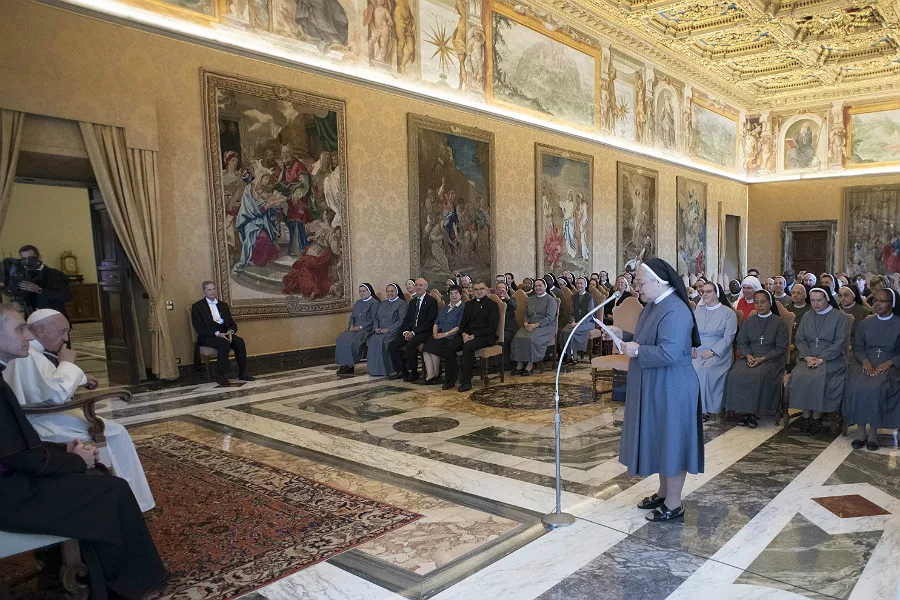
Vatican City, Jun 22, 2018 / 04:01 pm (CNA/EWTN News).- At the start of his Vatican City trial Friday, Msgr. Carlo Alberto Capella, a former diplomat for the Holy See, admitted to charges of the possession and distribution of child pornography while working in the U.S.
Capella, 51, a former Vatican diplomat, was recalled from the U.S. nunciature in Washington, D.C. last September after the U.S. State Department notified the Vatican of a “possible violation of laws relating to child pornography images” by a diplomat.
The first hearing in the civil trial was held the afternoon of June 22. Present alongside Capella were his psychologist, Tommaso Parisi; the Vatican’s Promoter of Justice, Roberto Zannotti; and judges Giuseppe Della Torre, Venerando Marano, and Carlo Bonzano.
In his testimony, Capella outlined the history of his diplomatic service to the Holy See and admitted his guilt, saying his crimes were the result of a “personal crisis” stemming from his transfer to Washington D.C.
Originally from Capri, Capella was ordained a priest of the Archdiocese of Milan and in 1993 was asked by Cardinal Carlo Maria Martini to enter the diplomatic service of the Holy See.
In 2004, after studying at the Pontifical Ecclesiastical Academy, he was sent to the apostolic nunciature in India, and three years later, in 2007, was transferred to the nunciature in Hong Kong.
Capella was then transferred back too the Vatican in 2011, and worked in the Secretariat of State’s office for Relations with the States.
In his testimony, Capella said he was happy there and enjoyed his work, and that prior to his time in Washington D.C., he had never viewed pornography or expressed interest in that type of content. But when he received a call June 30, 2016, asking him to move to D.C., Capella said he was unhappy with the move, but did not say anything.
“Unfortunately out of respect to the hierarchy, out of the sense of duty, I did not create problems. Instead of making my discomfort known to them, I thanked them for the transfer,” he said during the trial.
After arriving to the U.S., Capella said he had no enthusiasm for his work. The first four months, he said, were “bland,” and he felt “empty” and “useless.”
Problems began to arise, Capella said, when he started looking for funny memes and pictures of animals online to relieve his boredom. Referring to the use of pornography, he said “this kind of morbidness was never part of my priestly life” before this time of desolation.
When questioned by the Vatican’s prosecutor and lead judge about how this boredom led to the use of child pornography, Capella said he had started to use the micro-blogging site Tumblr July 23, 2016, to find the amusing images, which led to a slow slide into pornographic images.
This eventually turned into child porn, Capella said, explaining that he began using Tumblr’s chat function to exchange images, and had “vulgar” conversations with other unmarried persons.
The U.S. State department flagged Capella’s activity and informed the Vatican of a possible violation Aug. 21, 2017.
In September of that year, Canada issued a nationwide arrest warrant for the priest, who was then recalled to the Vatican. Police in Ontario said he had accessed, possessed, and distributed child pornography while visiting Windsor over the 2016 Christmas holiday.
Msgr. Capella has been held in a Vatican jail cell since April 9, 2018, and was indicted by the Holy See June 9.
In his own testimony during the hearing, Parisi said he met Capella after the priest had come back to the Vatican in October 2017, and that the priest had specifically asked for his services.
Capella had trouble sleeping when he first came back, Parisi said, explaining that he prescribed medication to help the priest sleep. The two have held counseling session twice a week since the priest came back to Rome.
According to Parisi, Capella is “aware of his role” in the crimes he committed, and has admitted his errors.
Gianluca Gauzzi, a computer engineer who works for the Vatican Gendarme, said that during the investigation he looked through three cell phones, two USB drives, and several hard drives.
In addition to the images he found on these, Gauzzi said he found additional images on a cloud storage which had been deleted from other devices, totaling in 40-55 images in all.
Gauzzi said he divided the images into two primary categories, one for images from Japanese comics, and the other for images of children aged 14-17. At least one video showed a child depicted in an explicit sex act with an adult.
The images, Gauzzi said, had been exchanged in chats.
Capella’s trial will resume the morning of June 23.
If you value the news and views Catholic World Report provides, please consider donating to support our efforts. Your contribution will help us continue to make CWR available to all readers worldwide for free, without a subscription. Thank you for your generosity!
Click here for more information on donating to CWR. Click here to sign up for our newsletter.




Leave a Reply